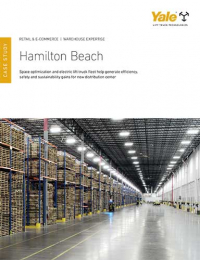Armstrong & Associates report points to steady gains in 3PL sector growth
In the report, Armstrong said that United States 2013 3PL gross revenue increased 7.4 percent, or by $10.8 billion, to $157.2 billion.
Latest Material Handling News
Lucas Watson appointed CSO for Körber’s Parcel Logistics business in North America Hyster recognizes Dealers of Distinction for 2023 Carolina Handling names Joe Perkins as COO Walmart deploying autonomous lift trucks at four of its high-tech DCs Kathleen Phelps to join FORTNA as chief financial officer More NewsThe bigger, the better could serve as a accurate description of the third-party logistics (3PL) sector, given the increasing activity of large-scale 3PL-related acquisitions, coupled with the steady revenue growth the sector has seen and is expected to see in the future, too.
That is a key takeaway of a new report issued this week by supply chain consultancy Armstrong & Associates Inc., entitled “Big Deal - 2014 3PL Results and 2015 Estimates.”
In the report, Armstrong said that United States 2013 3PL gross revenue increased 7.4 percent, or by $10.8 billion, to $157.2 billion. The report explained that this annual gain continues a pattern of single-digit growth, while at a far slower rate than it experienced from 2000-2008, when revenues more than doubled from $56.6 billion to $127 billion.
Individual market segments showed:
-domestic transportation management (DTM) gross revenue at $56.8 billion was up 15.4 percent annually, and net revenue at $8.5 billion was up 20.5 percent year-over-year;
-international transportation management (ITM) gross revenue at $47.3 billion was up 2.2 percent year-over-year, and net revenue at $18.4 billion was up 2.2 percent year-over-year;
-dedicated contract carriage (DCC) gross revenue at $13.2 billion was up 10.4 percent year-over-year, and net revenue at $13.1 billion was up 10.4 percent year-over-year; and
- value-added warehousing and distribution (VAWD) gross revenue at $36.8 billion was up 2.5 percent year-over-year, and net revenue at $28.4 billion was up 2.5 percent; and
-total 2014 3PL revenue at $157.2 billion was up 7.4 percent, with net revenue at $68.4 billion up 5.6 percent (this figure includes $3.1 billion for contract logistics software)
“The overall 3PL market results in terms of gross revenue from 2013 to 2014 was pretty much in line with what we had previously predicted,” said Armstrong & Associates Chairman Dick Armstrong. “Part of this is luck in the sense that the economics [metrics we are using are not jumping around much right now. U.S. GDP growth is at 2-to-2.5 percent, Europe is low, and so is Asia. 2014’s $157.2 billion for the U.S. market is about what you would expect.”
In terms of net growth drivers, Armstrong pointed to DTM and DCC leading the way, coupled with the U.S. economy being viewed as a bright spot over the last few years, with that expected to continue further into 2015 and beyond.
VAWD in 2014 increased at roughly the same rate as GDP, which Armstrong said was not surprising, and the 2.2 percent gross revenue increase for ITM was a byproduct of lagging global economic growth.
With DTM and DCC leading the way in terms of annual growth rates, Armstrong explained a major reason for that is shippers have awakened, on the DTM side, to the benefits of a strong relationship with 3PLs for managed transportation, especially in a sector like food and beverage, as an example of a sector where a shipper manages several thousand shipments per year. And oftentimes these shipments are managed on a lane-by-lane basis by a single 3PL, or one or two more, he added, for both truckload and less-than-truckload shipments.
“The largest shippers tend to rely on a small number of 3PL brokerage partners that they know and trust will do a good job for them,” he said. “Sometimes there is some regional variation, too, due to cross-border movements, but the fact is most companies realize when capacity is tight, they need a resource for extra coverage, which leads to building strong relationships with companies like C.H. Robinson, Coyote, or Echo Global Logistics. This is likely to continue, as there are around 40-to-50 DTM providers that are well-equipped through their service capabilities and IT capabilities to handle bucket loads of shipments efficiently. This works very well for most large shippers that want and need predictability and coverage, which is a big part of DCC, too.”
The report said that for DCC, a slow economy during the first quarter caused trucking demand to slacken, although current economic indicators point to modest growth that will tighten up supply, with rate increases continuing to exceed capacity growth.
The report made it clear that the proliferation of mergers and acquisition activity in the 3PL sector is making its part on the global 3PL sector. Some recent examples of those deals include XPO Logistics acquisition of Norbert Dentressangle and FedEx’ acquiring GENCO.
The report explained that these deals are reflective of a 3PL sector that is now dominated by about 50 companies located in post-industrial countries, with these players having scale based on geographic coverage, IT, and “processes that create threshold levels which bar smaller rivals from overtaking them with global growth alone.”

Article Topics
Latest in Materials Handling
Lucas Watson appointed CSO for Körber’s Parcel Logistics business in North America Hyster recognizes Dealers of Distinction for 2023 Carolina Handling names Joe Perkins as COO C-suite Interview with Keith Moore, CEO, AutoScheduler.AI: MODEX was a meeting place for innovation Walmart deploying autonomous lift trucks at four of its high-tech DCs Coles shops big for automation Kathleen Phelps to join FORTNA as chief financial officer More Materials HandlingAbout the Author
Subscribe to Materials Handling Magazine

Find out what the world's most innovative companies are doing to improve productivity in their plants and distribution centers.
Start your FREE subscription today.
April 2024 Modern Materials Handling

Latest Resources










